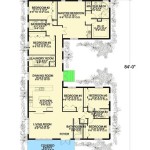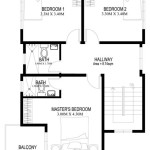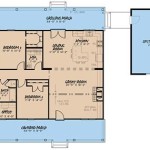How To Get a Floor Plan of Your House
Acquiring a floor plan of a house is a common requirement for various purposes. These range from planning renovations and redecorating to assessing property value or simply understanding the layout for furniture placement. Depending on the age of the house, the availability of existing documentation, and the level of detail needed, different methods can be employed to obtain a floor plan. This article outlines the various avenues for acquiring or creating a floor plan for a house, highlighting the pros and cons of each approach.
Consult Existing Records and Documentation
The first and often easiest step in obtaining a floor plan is to explore existing records related to the property. Several potential sources may hold this information. Investigating these resources proactively can save considerable time and expense.
Original House Plans: When a house is initially constructed, detailed blueprints and floor plans are typically created. These documents are often retained by the original homeowner or builder. Therefore, contacting the previous owner (if possible) or reaching out to local construction companies that specialize in residential development in the area can be beneficial. The possibility of these entities holding archival copies of the original plans should not be dismissed. Obtaining the original plans offers the advantage of accuracy and completeness, reflecting the precise dimensions and structural elements of the house as it was originally built. However, modifications or additions made after the initial construction might not be reflected in these plans.
Local Building Departments: Most municipalities require builders to file building permits along with detailed plans before commencing any construction project. These plans are typically stored in the records of the local building department or planning authority. Visiting the local building department and requesting access to the property’s file can often yield a copy of the original floor plan. There may be associated fees for accessing and copying these documents. It is crucial to check the department’s regulations regarding public access to building records. Access policies can vary depending on the jurisdiction. It's also important to note that these archived plans may not reflect any subsequent renovations or alterations done to the property.
Mortgage Lenders and Appraisers: When a house is purchased using a mortgage, the lender often requires an appraisal to determine the property's value. Appraisals frequently include a basic floor plan or sketch of the house's layout. While not as detailed as architectural blueprints, these sketches can provide a general overview of the room arrangement and dimensions. Contacting the mortgage lender or title company involved in the property's purchase might lead to the discovery of an appraisal report containing a floor plan. Keep in mind that these plans are typically less precise and not always to scale.
Real Estate Listings: Online real estate listings, brochures, or previous sales materials can sometimes include floor plans. While these are often simplified versions intended for marketing purposes, they might offer a basic understanding of the house's layout. Checking websites of real estate agents or browsing through archived property listings can be a quick way to gain a preliminary overview. However, the accuracy and completeness of floor plans in real estate listings cannot always be guaranteed. They are frequently used to entice potential buyers without strict adherence to dimensional accuracy.
Creating a Floor Plan Manually
If existing documentation is unavailable or incomplete, the alternative is to create a floor plan manually. This involves measuring the house's dimensions and drawing a scaled representation of the layout. This method requires careful attention to detail and patience.
Measuring Techniques: The first step in creating a manual floor plan is to accurately measure the dimensions of each room and hallway. Use a laser distance measurer or a long measuring tape for this purpose. Laser distance measurers offer increased precision and are particularly useful for measuring large rooms. Begin by measuring the length and width of each room, ensuring the measurements are taken at the floor level. Note the locations of doors, windows, and any built-in features, such as fireplaces or cabinets. Measure the thickness of the walls, both interior and exterior. This is vital for calculating the overall dimensions of the house. Pay close attention to angles and irregular shapes, noting any deviations from perfect squares or rectangles. Document all measurements meticulously, creating a detailed sketch as you proceed. This sketch serves as a preliminary guide for the final floor plan.
Drawing the Plan: Once the measurements are collected, use graph paper or a drafting software to draw the floor plan to scale. Choose an appropriate scale that allows the entire house to fit on the available paper or screen. For example, a scale of 1/4 inch = 1 foot is a common choice. Begin by drawing the exterior walls of the house, using the measurements previously recorded. Then, add the interior walls, ensuring they are accurately positioned and scaled. Incorporate the locations of doors, windows, and built-in features. Clearly label each room and indicate the dimensions. Use standard symbols to represent doors, windows, and other architectural elements. For example, doors are typically represented by an arc showing the direction of the swing. Double-check all measurements and drawings to ensure accuracy. Errors in the initial drawing can propagate and lead to significant discrepancies in the final plan. It's advisable to have someone else review the plan for errors, providing a fresh perspective.
Considerations for Accuracy: Creating a manual floor plan can be time-consuming and challenging, especially for complex house layouts. Achieving a high degree of accuracy requires meticulous attention to detail and a good understanding of architectural drafting principles. It's important to account for any structural irregularities, such as angled walls or uneven floors. These irregularities can significantly impact the accuracy of the floor plan. Consider using a combination of measuring tools, such as a laser distance measurer and a level, to ensure precise measurements. If the house has multiple stories, a separate floor plan will need to be created for each level. Ensure the plans align vertically, accurately representing the relationship between the different floors.
Utilizing Digital Tools and Professional Services
In addition to manual methods, several digital tools and professional services can assist in creating floor plans. These options offer varying levels of accuracy, detail, and cost.
Floor Plan Apps and Software: Numerous mobile apps and desktop software programs are available for creating floor plans. These tools often use advanced technologies, such as augmented reality (AR) or computer-aided design (CAD), to simplify the process. AR-based apps allow users to create floor plans by simply walking through the house and scanning the rooms with their smartphone or tablet camera. The app automatically measures the dimensions and generates a floor plan. CAD software provides more advanced features for creating detailed and accurate floor plans, but requires a higher level of technical skill. These programs allow users to draw walls, add doors and windows, and specify dimensions with precision. Some popular floor plan apps and software include Magicplan, RoomScan Pro, AutoCAD, and SketchUp. The choice of tool depends on the user's technical expertise and the desired level of detail. Many of these apps and software offer free trials or basic versions, allowing users to test the functionality before committing to a paid subscription.
Professional Surveyors and Architects: For the most accurate and detailed floor plans, engaging a professional surveyor or architect is recommended. Surveyors use specialized equipment, such as total stations and laser scanners, to measure the dimensions of the house with extreme precision. They can create highly accurate floor plans that include all structural elements, such as walls, doors, windows, and plumbing fixtures. Architects can also create floor plans, and they can provide additional services, such as design consultations and construction documentation. Hiring a professional surveyor or architect is the most expensive option, but it ensures the highest level of accuracy and detail. This is particularly important for complex renovation projects or when compliance with building codes is required.
Online Floor Plan Services: Several online services offer floor plan creation based on submitted photographs or sketches. These services typically employ professional drafters who create detailed floor plans from the provided information. This option offers a balance between cost and accuracy. It is less expensive than hiring a surveyor or architect, but it provides a more accurate and detailed floor plan than creating one manually. When using an online floor plan service, it is crucial to provide clear and accurate photographs or sketches. The quality of the input directly affects the accuracy of the final floor plan. Be sure to communicate specific requirements and desired level of detail to the service provider.

Design Your Own House Floor Plans Roomsketcher

Create A Floor Plan Of Your House Instructables

Design Your Own House Floor Plans Roomsketcher

Create A Floor Plan Of Your House Instructables

Floor Plan Creator And Designer Free Easy App

How To Find The Original Floor Plans For Your House

How To Draw A Floor Plan Live Home 3d

Design Your Own House Floor Plans Roomsketcher

How To Draw A Floor Plan The Home Depot

As Built Floor Plans
Related Posts








